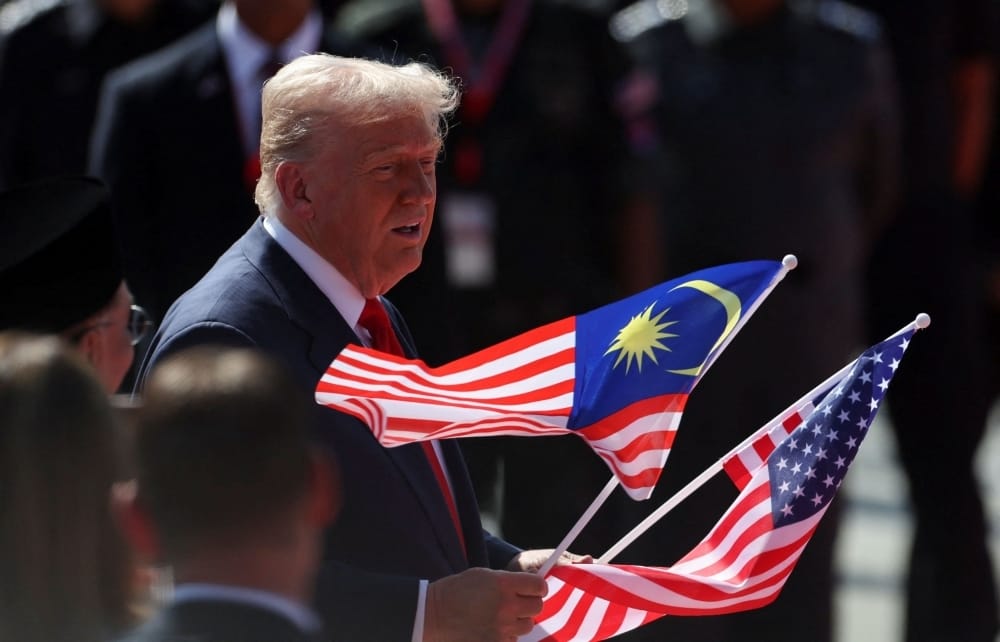🇲🇾 U.S.–China Trade Talks in Malaysia: What It Means for Penang and Malaysian Businesses

KUALA LUMPUR — Top economic officials from the United States and China began critical discussions in Malaysia this weekend, seeking to avert another escalation in their long-running trade war and to smooth the way for a much-anticipated meeting between U.S. President Donald Trump and Chinese President Xi Jinping next week.
The talks — held on the sidelines of the ASEAN Summit in Kuala Lumpur — are being watched closely across Southeast Asia. They come just days after Washington threatened to impose 100% tariffs on Chinese imports starting November 1, in retaliation for Beijing’s expanded export controls on rare earth magnets and strategic minerals.
But for Malaysia — and particularly for Penang’s export-heavy economy — the outcome of these negotiations could have direct consequences on trade flows, supply chains, and investor sentiment.
Malaysia in the Middle: Between Two Economic Giants
Malaysia’s unique position as a neutral trading partner and regional logistics hub makes it a natural bridge in the current U.S.–China standoff. According to Malaysia’s Ministry of Investment, Trade and Industry, the country is quietly pushing for “the lowest possible tariff exposure” in any future trade realignments — hoping to safeguard local exporters and foreign investors.
In fact, Trade Minister Tengku Zafrul Aziz recently emphasized that Malaysia will “continue to engage both sides to secure tariff stability” and “promote ASEAN integration as a counterweight to protectionist pressures.”
“ASEAN must deepen economic cooperation and present a unified response to rising global tariffs,” he said during the summit, echoing Malaysia’s long-term push for regional self-reliance.
Penang’s Strategic Role in the Global Supply Chain
For Penang — the nation’s semiconductor and electronics powerhouse — these talks hit close to home. The state’s industrial ecosystem, anchored by multinational giants in Bayan Lepas and Batu Kawan, is heavily dependent on stable global trade conditions.
Should the U.S.–China rivalry intensify, Penang could experience both risk and reward:
- Risk: Supply chain bottlenecks, shifting export rules, and sudden component shortages.
- Reward: Rising relocation of manufacturing from China under the “China + 1” strategy, with Penang likely to be a key beneficiary of new FDI inflows.
Local analysts note that each phase of U.S.–China tension has nudged high-tech investment into Malaysia. Penang, already dubbed the “Silicon Valley of the East,” stands to gain if companies accelerate diversification.
The Emerging AI & Semiconductor Angle
Adding to the complexity, Malaysia recently announced that AI chips of U.S. origin will now require a special trade permit before being exported or re-exported. The move, reported by Reuters in July, reflects Washington’s growing concern over technology transfer routes through Southeast Asia.
This could impact Penang’s advanced chip manufacturers, many of whom rely on U.S.-designed components but operate within supply networks intertwined with China. Local industry insiders say compliance costs may rise, but so will demand for trusted, certified Malaysian vendors who can navigate the new regulatory landscape.
What Malaysian Businesses Should Watch
- Tariff Exposure: If Trump’s 100% tariff threat materializes, expect currency volatility and temporary trade shocks. Malaysian exporters to both markets may face indirect pressure.
- Supply Chain Diversification: Firms dependent on Chinese imports or American clients should start building buffer strategies — multiple suppliers, alternate ports, or ASEAN partnerships.
- Government Incentives: Keep an eye on Malaysia’s trade diplomacy — recent signals suggest potential relief measures and investment incentives to cushion exporters if the trade war reignites.
- Investor Sentiment: A successful Malaysia-mediated dialogue could lift regional confidence and attract new FDI to Penang’s manufacturing base.
The Bigger Picture: Malaysia as Diplomatic Middle Ground
While the U.S. and China jockey for influence, Malaysia is playing an increasingly important role as a trusted mediator and stable trade platform. Hosting these talks not only reinforces Kuala Lumpur’s diplomatic credentials but also positions the country as a critical economic buffer for ASEAN.
And for Penang — where factories hum with exports worth billions in electronics — this is more than politics. It’s the heartbeat of the local economy.
“If tariffs rise, we tighten margins. If talks progress, our order books fill up,” said one Penang-based electronics CEO. “For us, global diplomacy translates directly into this quarter’s numbers.”
Final Word for the Penang Business Community
Whether you’re running a manufacturing firm in Bayan Lepas, a logistics outfit in Butterworth, or a growing SME tied to global suppliers — the U.S.–China trade story unfolding in Malaysia is your business story too.
As global giants negotiate in Kuala Lumpur, Penang must continue to invest in automation, R&D, and value-chain independence. The state’s resilience and agility could define how Malaysia navigates the next decade of shifting trade winds.
Malaysia may not decide the outcome of this trade war — but it can decide how prepared it will be for whatever comes next.
📚 Related Developments
- ASEAN must deepen integration to tackle US tariffs, Malaysia says
- Malaysia says trade permit required for AI chips of U.S. origin
- Malaysia targeting lowest possible tariff rate in US talks, trade minister says
Frequently Asked Questions (FAQ): U.S.–China Trade Talks in Malaysia & Their Impact on Penang
1. Why are the U.S. and China meeting in Malaysia?
Malaysia is hosting high-level talks between the United States and China on the sidelines of the ASEAN Summit. The goal is to prevent a new escalation in their trade war and to prepare for a meeting between Presidents Donald Trump and Xi Jinping. Kuala Lumpur provides neutral ground and diplomatic credibility within Southeast Asia, making it an ideal venue for dialogue.
2. What’s at stake in these U.S.–China talks?
The U.S. has threatened new 100% tariffs on Chinese imports, while China has expanded export controls on rare earth materials and magnets — key components in electronics and green tech. The talks aim to de-escalate tensions before these tariffs take effect and to protect global supply chains that heavily rely on both nations.
3. How does this affect Malaysia’s economy?
Malaysia’s economy is deeply linked to global trade, especially in electronics, palm oil, and semiconductors. Trade disruptions between the U.S. and China could:
- Impact export demand
- Increase input costs
- Affect currency stability
However, Malaysia could also benefit as multinational firms look to diversify manufacturing away from China, a trend known as the “China + 1” strategy.
4. Why is Penang particularly affected?
Penang is Malaysia’s manufacturing and export powerhouse, home to major semiconductor and electronics facilities. Any change in global trade policy — tariffs, tech bans, or export rules — directly affects the region’s industries. Penang stands to gain from relocation of factories out of China but could face risks from supply chain bottlenecks or compliance costs.
5. What opportunities could this create for Penang businesses?
- Increased foreign direct investment (FDI) from companies relocating out of China
- Growth in logistics and support industries as firms set up new regional bases
- Rising demand for local suppliers that meet global compliance standards
- Government incentives for upgrading factories and R&D capabilities
6. What risks should Malaysian SMEs prepare for?
Small and medium enterprises (SMEs) should prepare for potential:
- Price volatility on imported materials
- Delays in component sourcing
- Currency fluctuations
- Shifts in export regulations, especially for high-tech or dual-use goods
Diversification of suppliers and export markets is key to reducing vulnerability.
7. What’s the new rule about AI chips in Malaysia?
As of mid-2025, Malaysia requires trade permits for AI chips of U.S. origin before export or re-export. This aligns Malaysia with U.S. technology-transfer regulations and aims to prevent misuse or transshipment through third parties. For Penang’s semiconductor firms, this means tighter compliance but potentially greater trust from international partners.
8. How is the Malaysian government responding to trade tensions?
Malaysia’s Trade Minister has stated that the country is “targeting the lowest possible tariff exposure” in all negotiations. The government is also encouraging ASEAN integration and creating investment-friendly frameworks to attract manufacturing that’s relocating from higher-risk regions.
9. How can local businesses in Penang prepare?
Businesses can take practical steps to stay resilient:
- Conduct supply-chain audits to identify dependencies
- Build alternative sourcing channels in ASEAN
- Monitor U.S.–China trade developments weekly
- Leverage MIDA and state-level grants for digitalization and capacity building
- Form export partnerships through trade associations or local chambers
10. What’s the outlook for Malaysia if the talks succeed or fail?
- If talks succeed: Malaysia and Penang could enjoy stronger investor confidence, smoother trade flows, and new export opportunities.
- If talks fail: Expect short-term turbulence in currency, potential supply disruptions, and cautious investment sentiment. However, Malaysia’s neutrality may continue to attract long-term relocation of manufacturing.
11. What does this mean for everyday Malaysians?
While high-level trade talks may seem distant, their outcomes affect everything from factory jobs in Penang to consumer prices nationwide. If tariffs rise, import costs increase and inflation follows. If tensions ease, Malaysia’s economy — and particularly Penang’s export sector — could see renewed growth momentum.



